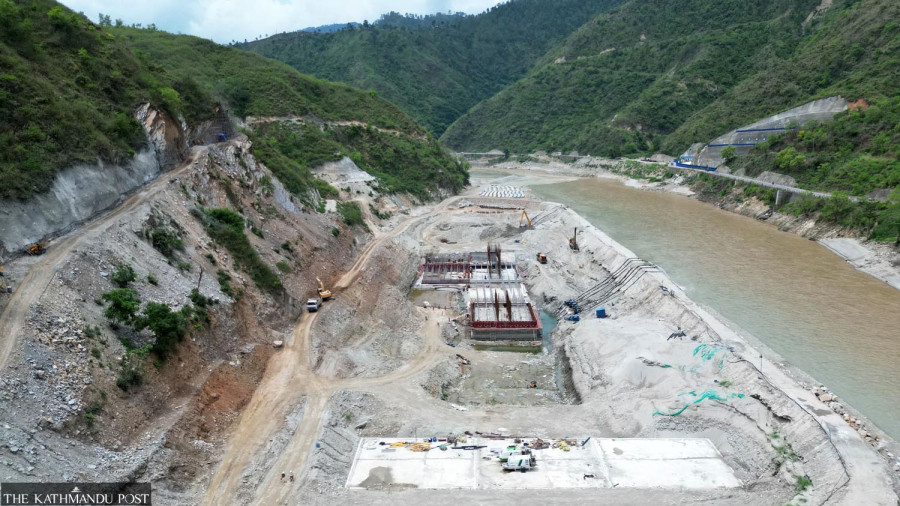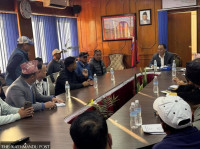Bagmati Province
Half of contract period passed, but Sunkoshi-Marin dam construction is just 7 percent complete
The Rs49 billion project which is expected to transform agriculture in five districts through year-round irrigation and generate electricity, is in limbo.
Bimal Khatiwada & Raj Kumar Karki
Despite high priority status of the Sunkoshi-Marin Diversion Multipurpose Project—the much-anticipated national pride project and a key to transforming agriculture in Tarai districts of Madhesh Province—progress on dam construction remains abysmally slow with only 7 percent work completed even though half the contract period has already passed.
Prime Minister KP Sharma Oli, during a visit to Madhesh province’s headquarters Janakpur in May, had sternly warned that the government would terminate the contract of the project if work did not accelerate. He emphasised that people in the Madhesh region could no longer leave their farmlands fallow while awaiting irrigation. "Delays in development projects are more criminal than corruption itself. Construction must move at rocket speed to meet the deadline," he had asserted.
The Sunkoshi-Marin project aims to divert water from the Sunkoshi river in Sindhuli district to the Marin river in Kamalamai Municipality, enabling irrigation across 122,000 hectares in five Tarai districts of Bara, Rautahat, Sarlahi, Mahottari and Dhanusha while also generating 31.07 megawatts of electricity.
The project’s heart, a 13.3-km tunnel will redirect part of the flow of the Sunkoshi river to the Marin river, a tributary of the Bagmati river, to irrigate farmlands in the central Tarai. The construction site is located in Sindhuli district, about 120 km southeast of Kathmandu on the BP Highway.
The proposed multipurpose project will inundate 312 hectares of land and create a lake in Sunkoshi and Khadadevi rural municipalities and Manthali Municipality affecting 3,026 households, as per a draft of the environmental impact assessment.
While the tunnel portion of the project has already been completed, dam construction along the Sunkoshi river at Kanadhungri in Sunkoshi Rural Municipality has progressed poorly. Tunnel work was executed using a tunnel-boring machine (TBM) by the Chinese contractor China Overseas Engineering (COVEC), allowing the tunnel breakthrough to be achieved three months ahead of schedule in May, 2024.
The COVEC was awarded the tunnel contract for Rs10.05 billion (excluding Value Added Tax), and the work began in October 2022 after the contract was signed in March 2021. The entire tunnel and treatment works are now ready for operation, but the system cannot be functional until the dam is constructed to feed water into the tunnel.
In contrast, the dam construction, being carried out by Patel-Raman JV under a Rs14.07 billion contract signed in January 2023, has made dismal progress. The JV was expected to complete the dam within 55 months—by 2027. However, in the 29 months since work began, only 7 percent physical progress has been made, well behind the expected 30 percent.
The pace of dam construction has suffered due to seasonal challenges, especially during the monsoon when work slows or halts completely due to floods damaging or burying built structures. Officials say the dam's foundation must be laid 12 metres below the Sunkoshi riverbed, with the structure eventually rising 18 metres above the river level to redirect water into the tunnel.
Sunkoshi-Marin project chief Badri Karki admitted that the dam work has seen only 7 percent progress, while Raman Construction’s financial director Raman Mahato claimed the figure is 14 percent. The discrepancy in numbers highlights confusion and lack of transparency in reporting.
Chief Minister of Madhesh Province Satish Kumar Singh, who plans to visit the construction site, criticised the sluggish progress. "The tunnel is ready, but dam construction is crawling. The contractor seems irresponsible. Delays are directly impacting farmers in the Madhesh," he said, warning that if performance doesn’t improve, the contract must be cancelled and reassigned.
Singh emphasised the project's transformative potential—not just for irrigation but also for groundwater recharge. “If completed soon, this project can double crop production and allow farmers to plant even in the off-season,” said Singh. Farmers currently depend on monsoon rains or deep boring, which increases production costs. “We must not allow any further delays. The federal government must intervene seriously,” he urged.
Construction of the cofferdam and sluice gates is underway. Mahato from Raman Construction cited initial difficulties. "It took nearly six months just to divert the river. The October floods buried structures and swept away materials. Transporting supplies to the site is extremely challenging,” he argued.
According to Mahato, flood-resistant measures have now been adopted and expressed confidence that 25 percent progress can be achieved within the next five to six months. However, he admitted some minor works may remain pending beyond the original deadline, for which an extension request has been made.
Sanjeeb Baral, director general of the Department of Water Resources and Irrigation, expressed concern over the delay in dam construction. "Progress is insufficient. We have issued repeated warnings and instructed the contractor to work in three shifts. If they continue to lag, we will terminate the contract," he warned. The department had advanced Rs 1.2 billion to the contractor as mobilisation fund. According to him, the department wrote a letter to the contractor to return Rs 600 million. “If they show results, we’re ready to roll out the red carpet to support them. But if they fail, we’ll find alternatives,” said Baral.
Upon completion, the 158-meter-long and 30-meter-high dam will direct the Sunkoshi river water to Marin in Kusumtar in ward 2 of Kamalamai Municipality through the tunnel. The water will then drop through a 66.29-metre head to generate 31.07 megawatts of electricity.
The overall project, with a total estimated cost of Rs 49 billion, has so far seen Rs 16 billion spent. But with just 35 percent of physical progress achieved, serious concerns remain about meeting the extended deadline of March 2028.




 16.12°C Kathmandu
16.12°C Kathmandu











